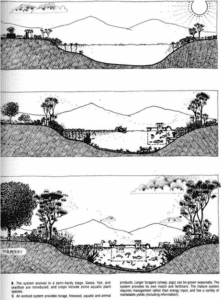Keeping Your Fish Healthy And Happy
The main variables contributing to fish health are oxygen and water temperature.
Again, your climate should dictate what types of fish you try to cultivate, so temperature shouldn’t be a problem unless you get some unseasonable extreme temperature spikes… and there’s not much you or any other aqua-farmer can do about that.
Oxygen must be monitored, though. If the oxygen level drops too low, your fish will drown.
Deoxygenation can be caused by:
- Too many fish
- Too much decomposing matter (e.g. dead plants and waste feed; you need to rake these out regularly and use for mulch)
- Too much live plant mass (plants absorb oxygen at night)
- A rise in temperature that lowers the dissolved oxygen content of water
If your oxygen levels are low, you’ll see the fish near the surface struggling to breathe, indicating an emergency situation. Even more dangerous, oxygen deficiencies usually occur at night when plants are absorbing more oxygen and when you are not around to see the fish. If you begin to notice any signs of deoxygenation in your water, you need to aerate it immediately before the fish die.
Aeration can take many simple forms…
- A fountain that sprays water into the air and falls back into the pond
- A paddle wheel
- A simple pump from the bottom of the pond that pumps low-O2 water into the top of a 55-gallon barrel filled with gravel in it situated on the pond bank, with a hole in it that releases the re-oxygenated water back into the pond can be the cheapest and most effective method
And always remember that a healthy pond has a great variety of all life.
A good way to inoculate a new pond is to get a bucket of mud from the bottom of a healthy established pond and to add it to your new pond. This will bring millions of healthy microorganisms to help start the life cycle for your own pond.
Feeding Your fish
Correct stocking of plants and other aquatic fauna, including inoculation of zooplankton from an existing pond, can generate sufficient feed for a reasonable amount of fish.

But pond productivity can be increased with the correct use of organic fertilizer or compost. Well broadcast over the pond, the fertilizer feeds the plants and zooplankton, which in turn feed the fish. Most fish don’t eat the waste directly, so there are no health risks, but you need to monitor oxygen levels if you’re fertilizing heavily.
Ducks living directly on a pond can do this fertilizing for you with no effort on your part, and they get a lot of their feed from the pond, too. (Synergy at its best!)
Trees planted nearby or overhanging (mulberry, for example) attract insects that fall into the pond and get eaten. If it can grow in your area, moringa is especially useful this way, too.
Another fun way to bring insects to your pond is to float a small raft with a solar-powered light and oscillating wall fan on top. Orient the light and fan in such a way that insects will be attracted at night and be blown directly into the water. This produces a staggering amount of nutrition for your fish to munch on each night.
Much of your farm and kitchen wastes can be fed directly to the fish.
Grain crops grown on the productive pond banks can be used when feed is short—these crops should be mulched by pond weeds for optimal output.
